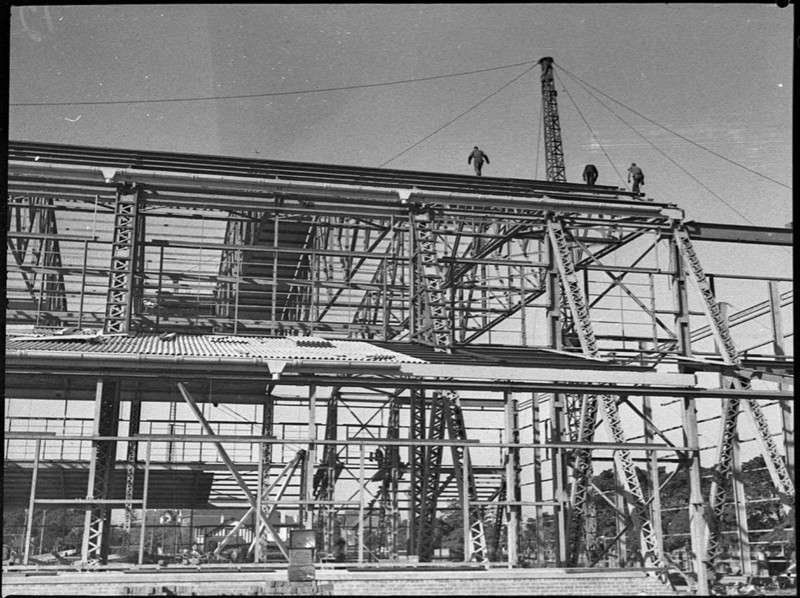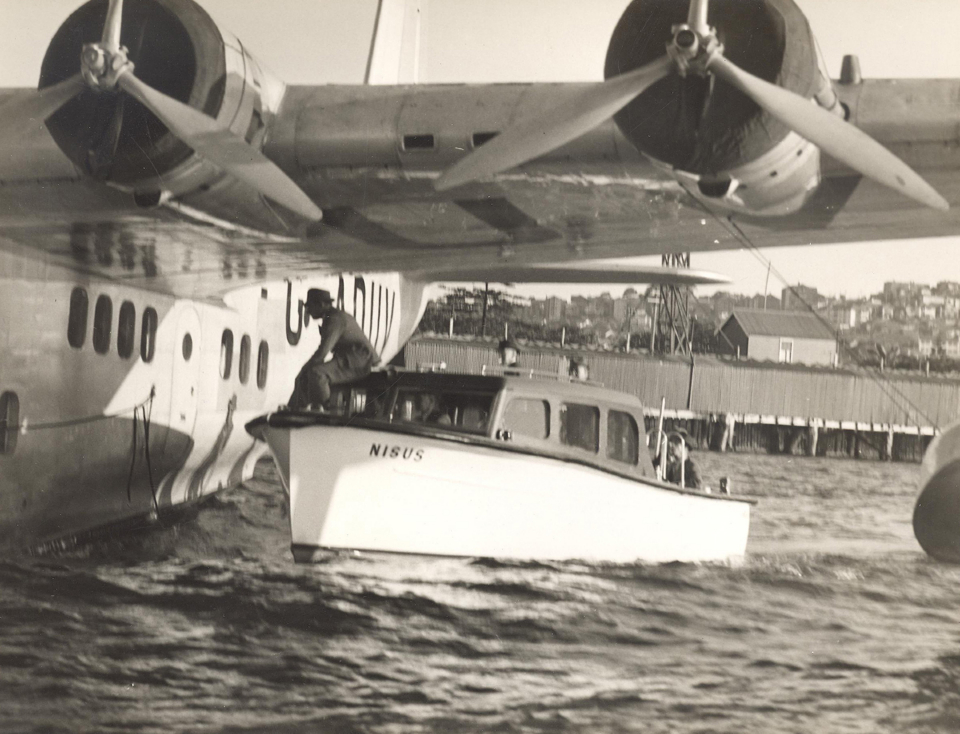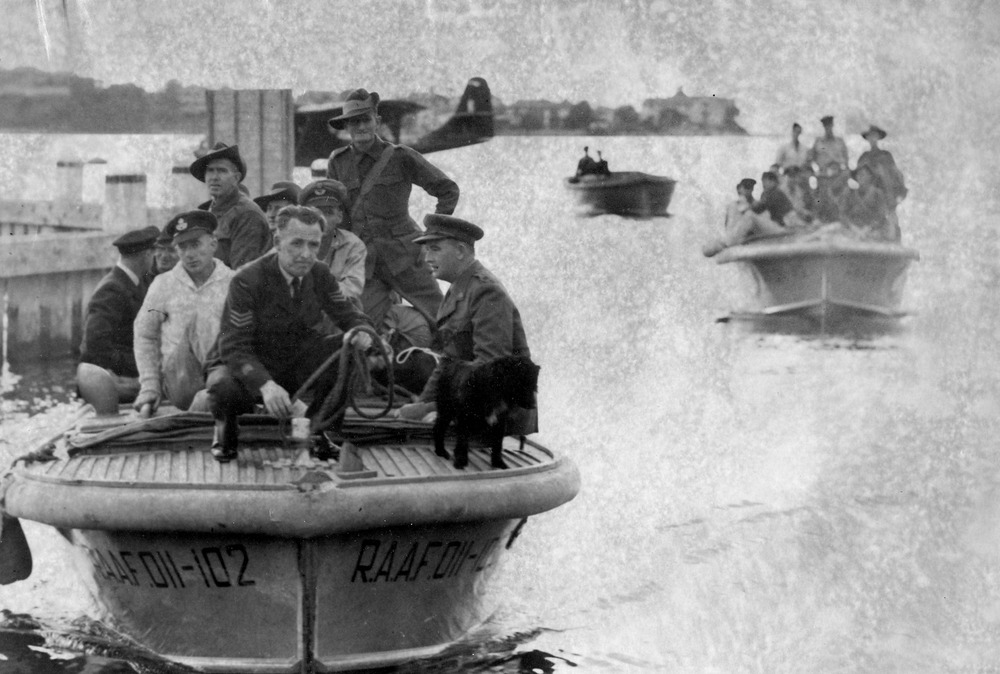The Dictionary of Sydney was archived in 2021.
Rose Bay Airport
Citation
Persistent URL for this entry
To cite this entry in text
To cite this entry in a Wikipedia footnote citation
To cite this entry as a Wikipedia External link
Rose Bay Airport
[media]Flying boats hold a special place in the transportation history of Sydney. A flying boat is an aircraft that can take off and alight from water, as the main body of the plane is a hull that rests fully on the water. [media]They were primarily designed to carry first class mail and were well suited to working on Sydney Harbour:
In the 1930s, when international aviation was in its infancy, there were only a limited number of airfields capable of coping with large aircraft ... An aircraft, which could land wherever there was a large enough patch of calm water and a mooring buoy, presented obvious advantages. [1]
The impetus for the introduction of flying boats to Sydney was the expansion of international airmail services.
An airport for Sydney Harbour
In January 1937 Australia agreed to participate in the Empire Air Mail Scheme (EAMS). [2] EAMS was a project developed by Sir Eric Geddes, chairman of Imperial Airways to move all mail within the British Empire by air.
[media]That year, despite some local community opposition, it was decided that Rose Bay would become the terminus of the United Kingdom to Australia airmail route and Australia's first international airport for flying boats. [3] The only alternative location considered was Botany Bay but a large breakwater would need to have been built. This would have cost £600,000 and taken three years to complete, and so it was ruled out.
[media]A base was built at Rose Bay that included a large hangar on land, with slipways and terminal facilities for the boats and passengers. The building of the hangar was not without incident: a rigger, William Hayes, died when a steel truss fell and crushed his head. [4]
Six Short S23 'C' Class Empire flying boats were produced for Australia by Short Brothers at the Rochester Seaplane works in the UK. These boats were named: Coolangatta, Cooee, Carpentaria, Corio, Coogee and Coorong. [5]
Passenger services
[media]Flying boats soon evolved to carry passengers. The first full service from Sydney to Southampton departed on 5 July 1938, with the Empire Flying Boat and Air Mail Service Cooee flying a first-class service with 30 stops between Sydney and London, thus creating the now famous 'kangaroo route'. [6] Flights travelled along the east coast to Singapore then via Bangkok, Calcutta, Karachi, Alexandria, Basra, Marseilles and onto Southampton. [7] This was a ten-day 'codeshare' flight between Imperial Airways and Qantas Empire Airways. A reporter on board the first flight from Sydney commented:
Whatever may be the case in Darwin, or elsewhere, none could coin a syllable of anything but admiration and praise for the facilities at the Rose Bay airport … [8]
[media]There were fifteen passenger seats, an air crew of two and a cabin crew of three to service the flight. The start of the service to England also saw the Qantas headquarters move from Brisbane to Sydney.
[media]The official opening of the Rose Bay airport, by Lord Huntingfield, Acting Governor General, was on 4 August 1938. [9] Wilmot Hudson Fysh, Managing Director of Qantas at the time, commented on the [media]quality of the flying boats:
Getting up out of his chair, a passenger could walk about and, if he had been seated in the main cabin, stroll along to the smoking cabin for a smoke, stopping on the way at the promenade deck with its high handrail and windows at eye level to gaze at the world of cloud and sky outside, and the countryside or sea slipping away below at a steady 150 mph. [10]
[media]In-flight full restaurant service was introduced and the meals were promoted to passengers:
Would madam care for roast mutton with peas and crème potatoes? Or would she prefer ham or pressed beef, or ox tongue with vegetable or green salad? [11]
Flying boats in war time
[media]With the advent of World War II, flight services were increasingly disrupted and, in 1942, were suspended. The flying boat aircraft were called upon by the RAAF to support the war effort, ferrying supplies and carrying out reconnaissance operations.
[media]Two weeks after World War II ended, on 16 September 1945, nine Catalina flying boats landed at Rose Bay, repatriating Australian prisoner of war survivors from Japanese camps. They were greeted by 50,000 spectators, and hundreds of small boats were there to meet the returned POWs. [12].
The golden age of travel
[media]Flights to London resumed on 18 May 1946. The post-war period was the golden age of luxury flight travel when flying was strictly reserved for the well heeled. In 1947 a return flight to Australia from England cost more than one hundred times the average annual wage. [13]
[media]By the early 1950s, with the arrival of jet airliners, the gradual demise of the flying boats began. In 1955 Qantas discontinued its flying boat service and sold its aircraft to Ansett Airways. Ansett Flying Boat Services continued to operate flights to Lord Howe Island until the service was discontinued in 1974. [14]
A commemorative plaque in Lyne Park reminds passers-by of the airport that once existed there. The airport is referred to by the International Air Transport Association (IATA) using the airport code RSE. [15] Today a commercial company operates commuter flights to and from Palm Beach, as well as flights over the Harbour and short stops. [16]
Further reading
'The Golden Age of Flying Boats in Australia.' Club Marine Magazine 19 (6). http://www.clubmarine.com.au/internet/clubmarine.nsf/docs/MG19-6+Feature
Sydney Living Museums. 'Flying Boats: Sydney's Golden Age of Aviation.' Past Exhibition, Museum of Sydney. http://sydneylivingmuseums.com.au/exhibitions/flying-boats-sydneys-golden-age-aviation
Wilmot Hudson Fysh. Qantas at War. Sydney: Angus and Robertson, 1968.
Notes
[1] 'The Golden Age of Flying Boats in Australia', Club Marine Magazine 19 (6), viewed 25 October 2014, http://www.clubmarine.com.au/internet/clubmarine.nsf/docs/MG19-6+Feature
[2] John Gunn, The Defeat of Distance: Qantas 1919–1939, (St Lucia: University of Queensland Press, 1985), 301
[3] The Sydney Morning Herald, 23 July 1937, 10
[4] Examiner, 23 March 1939, 10
[5] Wilmot Hudson Fysh, Qantas at War (Sydney: Angus and Robertson, 1968), 63
[6] '23 September 2011: Sydney's Flying Boats', Scratching Sydney's Surface, viewed 23 October 2014, http://scratchingsydneyssurface.wordpress.com/2011/09/23/23-september-2011-sydneys-flying-boats/
[7] 'Qantas Empire Airways, 1 June 1939', from the collection of Michael Dawes, Airline Timetable Images, viewed 23 October 2014, http://www.timetableimages.com/ttimages/complete/qf39/qf39-1.jpg
[8] The Sydney Morning Herald, 6 July 1938, 16
[9] 'Proud Day' Rose Bay Air Terminal Opened, Newcastle Morning Herald and Miners' Advocate, 5 August 1938, 20
[10] Wilmot Hudson Fysh, Qantas at War (Sydney: Angus and Robertson, 1968), 71
[11] Wilmot Hudson Fysh, Qantas at War (Sydney: Angus and Robertson, 1968), 72
[12] Steve Creedy, 'Golden age of flying boats', The Australian, 2 May 2008, viewed 23 October 2014, http://www.theaustralian.com.au/business/aviation/golden-age-of-flying-boats/story-e6frg95x-1111116220815
[13] 'Airplanes', Ten Pound Pom, viewed 23 October 2014, http://tenpoundpom.com/pages.php?pageid=39
[14] The Canberra Times, 10 September 1974, 3
[15] Fubra Ltd, World Airport Codes, viewed 25 October 2014, http://www.world-airport-codes.com/australia/rose-bay-7234.html
[16] Sydney Seaplanes, viewed 25 October 2014, http://www.seaplanes.com.au/
.















